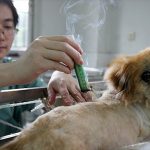In The Case Of Canine Parvo Virus

When I was a kid growing up I lived with a menagerie of cats, dogs, lizards, and hamsters. We never worried about diseases, we never vaccinated, and our animals rarely got sick. And, we never saw the vet, except for that one time our Tom Cat had a nasty abscess on the top of his head from a territorial backyard fight. In those days there wasn’t a craziness to vaccinate. But, fast forward decades later and now there’s a vaccine for everything. Some veterinarians literally push them on pet owners. As a result, new strains of diseases have emerged and old diseases have mutated and become more resistant. If man had left Nature alone most of these diseases would have disappeared on their own.
One such disease that strikes fear in the heart of dog owners is the Canine Parvo Virus. It is a disease that suddenly appeared in 1978 and spread like wildfire. Below is an article from Mogens Eliasen on the Parvo-virus. The original title is “The Parvo Hype.” I’d like for him to explain what Parvo is all about:
Parvo has been one of the biggest money-makers ever in the pet vaccine industry. It is supported by emotions, misinformation, fear monger, and lack of fundamental knowledge from the dog owners’ side. There are no facts whatsoever to support a risk management proposition in favor of vaccination against that disease.
What Is Parvo?
Parvo is a man-made virus mutation. Created by irresponsible people in a virus lab experimenting with stuff that could have been an attempt to initiate biological warfare in Vietnam – who knows. Canine parvovirus is very similar to the feline panleukopenia virus (FPV). Soon after its appearance, parvo was classified as a mutation of FPV – in fact, the first vaccines used against parvo were FPV vaccines. Prior to the parvovirus outbreak, the only widely-used vaccine for dogs was distemper. At some point, cats’ kidneys were used to develop the distemper vaccine and this was shipped around the world and injected into dogs. It’s been speculated that the distemper vaccine was grown on cat kidney cells that were infected with FPV.
(My note: If it’s true, what a bunch of irresponsible lab workers to not first test the kidney tissues for any contaminations. It’s interesting to note there is only two amino acids difference between parvo and FPV).
Another possibility is that cats that were vaccinated for FPV shed the vaccine through their feces, a very real risk with modified live vaccines. The feline parvovirus could have easily mutated into canine parvovirus. In the book Vaccines For Biodefense And Emerging And Neglected Diseases, the authors state that the trouble with modified live vaccines is: there is a high probability of back mutation and reversion to virulence once introduced to the animals. Whatever the cause, the patent on the vaccine is now a billion-dollar income source!
The worst part of it is that there is no way the disease could have been spread as fast as it did over 5 continents, if it would have been left to expanding its territory on its own, by transfer from animal to animal. The only possible way of achieving a world-wide spread in a matter of the few months it took is by distributing the virus through vaccines! (It is an interesting thought that if we had not been to keen on vaccinating our dogs so much, then Parvo could not have propagated as it did, but would possibly have been easy to isolate in a few small regions. Producing and distributing vaccine is not free of liability and risk!)
Parvo is a virus that primarily attacks growing cells. That’s what sometimes makes it fatal for young puppies that still suckle. That’s also what makes it totally harmless for adult dogs.
However, it is rarely the virus itself that kills, if ever. It is most often the side effects of its presence, vomiting and diarrhea, that are the primary death reasons – they can be so violent that the puppy dies of dehydration.
The bad news is that this can go very fast: a matter of hours, not days. In other words: you do not have “till tomorrow” if you want to save your puppy.
The good news is that there are some fairly effective treatment options available for you, such as, Amber Naturalz herbal product called Paxaid (The name of product has since changed. Contact Amber Naturalz) which has been on the market since 1997.
(My note: if you have an expectant dam, keep a homeopathic emergency kit or Paxaid on hand prior to birth. I’d also like to suggest Homeopathic nosodes. You can speak to me or another homeopathic practitioner on the use and timing of nosodes. Make sure your homeopathic emergency kit contains Nux Vomica, Arsenicum album, and Phosphorus, at 30C and 200C).
How Does A Dog Get Parvo?
The virus can survive for years in soil. It can attach itself to almost anything, including dust that is blown with the wind, the soles of your shoes, the skin of your hands. It resists heat and frost, moisture and drought (My note: some say the virus is also unharmed by detergents, alcohols and common disinfectants). It is everywhere. Even wolves in the wild get it nowadays. Simply by you walking on some contaminated ground can be enough to bring the virus home to your dog. It is virtually impossible to protect your dog against the exposure. However, some areas are worse than others, and some of the very worst are the veterinary clinics! In other words: bringing your puppy to the veterinary hospital in order to vaccinate it against Parvo is madness. You can be certain of vastly increasing your risk of the puppy contracting Parvo from that visit before it can generate any immunity from the vaccination.
Exposure, however, is not enough for the puppy to contract Parvo. It takes exposure plus a weakened immune system. As long as you keep the immune system strong, your puppy is not in danger, no matter the exposure!
I can add to this that I have seen about 150 dogs in my classes over a 10-year period come down with Parvo 2-4 weeks after they got vaccinated. Of course, when those students went back to the vet that gave the vaccine, “it simply could not be Parvo.” But when I learned that lesson and asked my students to let another vet take a look without telling anything about the vaccination, the diagnosis came clean and clear every single time: PARVO! Sure, 150 dogs out of about 3,000 is only 6%… I never saw a case of Parvo among the dogs that were not vaccinated – and they counted about 10% of all my students and they never had any health problems from the exposure to the other dogs in the classes.
This is simply not compatible with the scaremonger.
What About The Parvo Vaccine?
As you can understand, vaccination against Parvo is a farce. Or a scam. Since the disease is no serious threat to adult dogs, but primarily kills puppies at the age of 4-6 weeks. Vaccination is simply not a responsible option!
The reason is that puppies cannot generate immunity against any disease until they are 10-12 weeks old. Till then, they rely 100% on the protection they get through the mother milk, the so-called “maternal antibodies.” If the mother is healthy and has good protection herself against Parvo, and the puppies suckle till they are about 8 weeks old (as they should), they will remain well protected till they are 12-16 weeks old. Any attempt to vaccinate before they have developed the capability of responding with a counter-attack through their own immune system, the maximum you can expect from a vaccination is that the vaccine will destroy the maternal antibodies – and leave the puppy even more vulnerable than it was before! On top of that, the vaccine is not free of other side effects. It is actually very poisonous, and it will weaken the entire immune system at a time when it is not even fully ready to defend itself.
Also, I know of at least 5 other people who had the same experience as I had when I brought home a new puppy some years ago from what I thought was a responsible breeder: In accordance with our contract, the breeder was not supposed to vaccinate the puppy. But she did – on the very day I came to pick it up… 5 weeks later, this little female almost died from Parvo; in 9 days, her weight went from 9 kg below 5 kg. She literally lived on IV and did not move at all for over a week….
I cannot say if it would have been less bad if this puppy had not been vaccinated. But I can certainly say that the vaccination did absolutely nothing to prevent exactly what it was supposed to prevent. And this experience fits into the picture.
Blood-letting would, seriously, be a less irresponsible alternative!
Update (2025): Puppies vaccinated for the Parvo Virus shed live, infectious virus around the community for an average 19 days post vaccination. And 23% of adult dogs are still shedding it 28 days later. Worse, Parvo is hardy. It is resistant to rain and freezing, and can survive more than 6 months in poop on the ground. This makes it concerning for dogs that are at high-risk (poor immune system). Read more information HERE and HERE
How Do We Deal With Parvo?
The good news is that the number of puppies that will die as a result of Parvo attacks is not big enough to destroy the species. But it will soon be if we do not allow this natural immunity to propagate throughout all breeds – and we can only make that happen when we stop the vaccination madness against diseases that charge only a moderate toll and are completely non-dangerous to adults.
I personally know of dozens of non-vaccinating breeders who have lost 1, maybe 2 puppies to Parvo. But not at all this “swiping plague that kills everything”, except among breeders who vaccinated! It is nothing but a money-making myth for veterinarians and vaccine manufacturers. The sad truth most probably is that when we breed dogs who are so completely destroyed by over-vaccination that their immune system no longer can function, the transfer of immunity to puppies through the mother milk is jeopardized. Over-vaccination is a evil circle, and we need to break it before we destroy our dogs.
This is not a matter of saving every single puppy we possibly can breed. It is a matter of saving enough healthy ones to carry on the powers of an immune system that can handle the disease.
It has been my observation, through following the communications on many bulletin boards and in numerous newsgroups on-line, plus thousands of students and clients of mine, that people who feed their dogs a healthy raw diet and do not vaccinate, rarely get Parvo – and when they do, the attack is mild, with only minor losses, if any. It would be interesting to quantify this in a dedicated study, and, some day, it will hopefully be done. Till then, we have to make our decisions based on our combined experience.
We need to remember that the virus is virtually everywhere. There is no protection possible, other than breeding healthy dogs with a strong immune system. When vaccination is no option either, we need to look elsewhere for help.
Latest New Treaments For Parvo
My Note: Recently, fecal microbiota transplants (FMTs) are also being used for puppies with parvo infections with promising success. A fecal microbiota transplant is a procedure where the stool from a healthy donor is transferred into the gastrointestinal tract of the recipient. (See Study). For more information on fecal transplant for animals, please see my blog.
In addition, as of May 2023, Elanco Animal Health announced that the U.S. Department of Agriculture (USDA) had granted the company a conditional license for the first monoclonal antibody therapy to treat canine parvovirus.
The veterinary journal Clinician’s Brief, Canine Parvovirus Monoclonal Antibody (CPMA) targets parvovirus directly and works by selectively binding and blocking parvovirus from entering and destroying enterocytes. One IV dose can shorten the disease course and improve patient outcomes. Further, CPMA carries a high safety profile and has been shown to be well-tolerated in patients as young as 6 weeks of age (See AAHA article).
The Strategy Should Be This:
Make sure that the dam we breed is in good health and shows good protection against the virus. A titer test would be a reasonable thing to have done to be certain that this protection is in place – as far as we can measure it (Titers are no guarantee of protection, and absence of titers do not indicate lack of protection – but presence of titers in a healthy body does indicate an alert and potent immune system; positive titers thus simply increase your odds of success).
Pamper the pregnant and nursing bitch, just as a pack of wolves would do: let her eat the food she likes the most, from natural sources, of course (if you mix in also unnatural sources of food, like kibble, you completely screw up the value of this – if you are not outright going to make thing much worse).
Keep Paxaid on hand, just in case (It is an herbal mix from Amber Naturalz in California. It has shown to provide a great support for puppies that get attacked by Parvo. If you have it available for immediate use, you can expect the mortality among your puppies to be lower than 10%).
Do not wean the pups! Let the mother take care of their nursing for the longest possible time!
Feed the puppies a responsible, raw, natural diet from the day they no longer suck.
Provide moderate exposure to the environment, one step at a time, so the immune system can handle the diseases it gets in contact with one by one; reduce the risk for multiple exposures as much as you can.
Watch for the symptoms – and get help immediately when/if you identify the possibility of a Parvo attack! “Immediately” does not mean “tomorrow, when the veterinary clinic opens”. It means “now.”
If all breeders do this, then in 10 years, Parvo will be nothing more than a flu we won’t even notice. But if we don’t stop the ridiculous vaccination madness, we will not have a single dog left with a healthy immune system 30 years from now.
Treating Parvo With Chinese Herbal Medicine: A Study
My Note: A 2024 clinical study from the UK suggests that integrating Zhi Li Tang (Red Back Door) with conventional treatment of canine parvoviral enteritis could reduce mortality from parvovirus infections in shelter dogs (See study).
Further Information:
Mogens Eliasen holds a mag. scient. degree (comparable to a US Ph. D.) in Chemistry from Ã…rhus University, Denmark, has a extensive education also as military officer and in business management. He has been working with dogs, dog owners, dog trainers, and veterinarians since 1970. A large part of his dog work has been in the area of education and education planning, and as consultant for dog owners and dog training associations. He is a strong advocate of treating the dog with respect for its nature as domesticated wolf, and has published several books and videos on topics related to dogs, dog training, dog behavior, and responsible care of dogs. He publishes a newsletter “The Peeing Post” containing lots of tips and advice on all matters pertaining to dogs.
Disclaimer: The entire contents of this website are based upon the opinions of Anthea Appel, unless otherwise noted. Individual articles are based upon the opinions of the respective author, who retains copyright as marked. The information on this website is not intended to replace a one-on-one relationship with a qualified pet health care professional and is not intended as medical advice. It is intended as a sharing of knowledge and information from the research and experience of Ms. Appel and her community. Ms. Appel encourages you to make your own pet health care decisions based upon your research and in partnership with a qualified pet health care professional.










